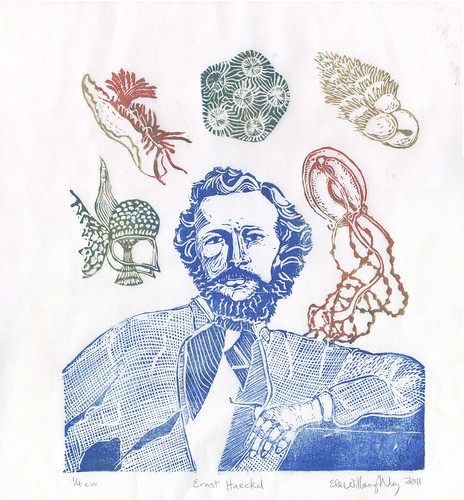Sometimes the artifacts of science are beautiful in and of themselves. This is of course true of most biological specimens, as lifeforms themselves are beautiful. Thus you do see them recreated in various media. Today I bring you textile art specimens. Be sure to also see previous
magpie & whiskeyjack posts
Naturalia & Mirabilia on the art of Lyndie Dourthe,
Barnacles which includes crocheted marine creatures like the
Hyperbolic Crochet Coral Reef,
Felt & Food Geology about the photos of Eszter Burghardt, and
Doily Science on Lisa Solomon's anatomical and chemical doilies.
Laura Splan's microbial doilies "explores the 'domestication' of microbial and biomedical imagery. Many recent events, epidemics, and commercial products have brought this imagery into our living rooms, kitchens, and bathrooms," by employing this old-fashioned, domestic medium.
all by
Laura Splan, 2004
freestanding computerized machine embroidered lace mounted on velvet
16.75H x 16.75W inches each (framed dimensions)
(via
she walks softly)
Her 2002 'Vigilant' show also featured hand latch-hooked yarn on stretched latch-hook canvas images of petri dishes of various microbes.
Laura Splan, Vigilant, 2002, hand latch-hooked yarn on stretched latch-hook canvas, 120H x 204W inches (installation dimensions variable)
I've mentioned Australian artist
Helle Jorgensen previously (for her crocheted
Barnacles) but her plastic crochet sea creatures are worth exploring again.
Helle Jorgensen, 'Diploria'

Helle Jorgensen, 'Medusa'
Helle Jorgensen, 'The Retail Reef'
Laura Katherine McMillan's fibre art Petri dishes are quite lovely.
Laura Katherine McMillan, Cell series
Jessica Polka has made some wonderful fibre art specimens, from sea creatures to mushrooms (and she sells crochet patterns through her
Etsy shop, which she describes as a
wunderkammer, much to my delight).

Jessica Polka, chiton anatomy
Jessica Polka, mollusk anatomy
Jessica Polka, scaphopod anatomy
(you should also check out her
laser-cut Turing patterns and her blog in general!)
Aubrey Longley-Cook's embroidered animals include their skeletons. See more on
his blog spool spectrum.
Aubrey Longley-Cook
Amongst other work,
Andrea V. Uravitch has made small insects and bugs from embroidered and sewn fabric and wire.
Andrea V. Uravitch
Andrea V. Uravitch
Hiné Mizushima makes wonderful and whimsical needle felted sculptures, including a variety of biological specimen.
Hiné Mizushima, Giant Daphnia brooches
Hiné Mizushima



































